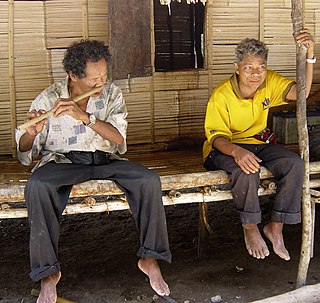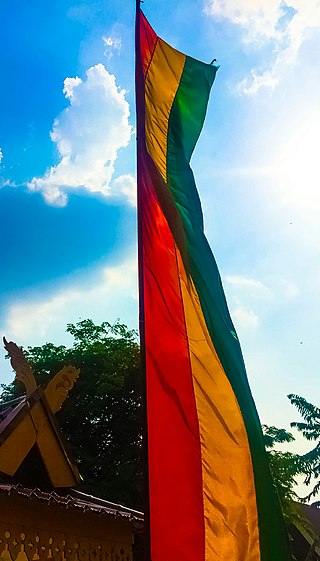Related Research Articles

The Semang are an ethnic-minority group of the Malay Peninsula. They live in mountainous and isolated forest regions of Perak, Pahang, Kelantan and Kedah of Malaysia and the southern provinces of Thailand. The Semang are among the different ethnic groups of Southeast Asia who, based on their dark skin and other perceived physical similarities, are sometimes referred to by the superficial term Negrito.

Orang Asli are a heterogeneous indigenous population forming a national minority in Malaysia. They are the oldest inhabitants of Peninsular Malaysia.

Jakunpeople or Orang Ulu/Orang Hulu are an ethnic group recognised as Orang Asli of the Malay Peninsula in Malaysia.

The Semai are a semi-sedentary ethnic group living in the center of the Malay Peninsula in Southeast Asia, known especially for their nonviolence. This characterization was made by Robert Knox Dentan, an anthropologist who studied the Semai in the 1960s, though he offered a more nuanced view after subsequent fieldwork. They speak Semai, an Austroasiatic language closely related to Temiar, spoken by Temiars nearby. The Semai are bordered by the Temiars to the north and the Jah Hut to the South. The Semai belong to the Senoi group, and are one of the largest indigenous ethnic group in the Peninsula and the largest of the Senoi group. Most Semai subsist by cultivating grain crops, hunting, and fishing.

The Batek people are an indigenous Orang Asli people ; belonging to the Semang group, who live in the rainforest of peninsular Malaysia. As a result of encroachment, they now primarily inhabit the Taman Negara National Park. The Batek are nomadic hunters and gatherers, so the exact location of their settlements change within the general confines of the area that they inhabit.

The Mah Meri are an ethnic group native to western part of Peninsular Malaysia. They are one of the 18 Orang Asli groups named by the Malaysian government. They are of the Senoi subgroup. Most of the members of the Mah Meri tribe live along the coast of South Selangor from Sungai Pelek up to Pulau Carey, although there is at least one Mah Meri Community on the other side of the Klang River.
The Duano' people, also called Desin Dolak or Desin Duano' are an indigenous people of Malaysia and Indonesia and can be found in islands along the northeastern region of Sumatra, Indonesia where most Duano' people have traditionally lived. They are one of the Proto-Malay group of cultures. Due to their nomadic boat lifestyle, based almost exclusively on fishing and collecting shellfish and crustaceans by using mud-boards, Duano' people are often categorized as Orang Laut, a group that includes the Urak Lawoi’ people and Moken people of the northern region of the Malacca Strait and the Andaman Sea. Although there are similarities in their way of life, they are a separate ethnic group. Citing their own language, culture, identity, and economic complexities, they deny being Orang Laut.

The Temuan people are a Proto-Malay ethnic group indigenous to western parts of Peninsular Malaysia. They can be found in the states of Selangor, Pahang, Johor, Negeri Sembilan and Malacca. The Temuans are classified as part of Orang Asli group according to the Malaysian government. They are also one of the largest and the most widespread of the Orang Asli ethnic groups.

The Senoi are a group of Malaysian peoples classified among the Orang Asli, the indigenous peoples of Peninsular Malaysia. They are the most numerous of the Orang Asli and widely distributed across the peninsula. The Senois speak various branches of Aslian languages, which in turn form a branch of Austroasiatic languages. Many of them are also bilingual in the national language, the Malaysian language.

The Orang Asal are the indigenous peoples of Malaysia. The term is Malay for "Original People", used to refer to the aboriginals of Sabah, Sarawak, and Peninsular Malaysia. These groups are given the Bumiputera status in Malaysia.

The Temiar are a Senoic group indigenous to the Malay Peninsula and one of the largest of the eighteen Orang Asli groups of Malaysia. They reside mainly in Perak, Pahang and Kelantan. Their total population is estimated at around 40,000 to 120,000, most of which live on the fringes of the rainforest, while a small number have been urbanised.
Orang Kanaq are one of the 18 Orang Asli ethnic groups in Malaysia. They are classified under the Proto-Malay people group, which forms the three major people group of the Orang Asli. The Orang Kanaq are considered as the smallest Orang Asli group with the population of approximately 90 people only.
The Department of Orang Asli Development, abbreviated JAKOA, is the Malaysian government agency entrusted to oversee the affairs of the Orang Asli. This body is under the Malaysian Ministry of Rural and Regional Development and was first set up in 1954.
The Lanoh are a group classified as "Orang Asli" of the Semang branch by the government of Malaysia. They live in the Malay Peninsula and number around 390. They are also known as Sabub'n or Lano. However, the Lanoh community in Gerik and Lenggong, Perak would identify to themselves as Menik Semnam, a name that refers to the Lanoh people that lived at the Semnam River. Whereas the Malay community in Upper Perak would refer the Lanoh people as Sakai Jeram.

Malayisation or Malayization is a process of assimilation and acculturation, that involves acquisition or imposition of elements of Malay culture, in particular, Islam and the Malay language, as experienced by non-Malay populations of territories fully controlled or partially influenced by historical Malay sultanates and modern Malay-speaking countries. It is often described as a process of civilisational expansion, drawing a wide range of indigenous peoples into the Muslim, Malay-speaking polities of Maritime Southeast Asia. Examples of Malayisation have occurred throughout Asia including in Brunei, Cambodia, Indonesia, Malaysia, Singapore, and Sri Lanka.
The Sagong Tasi case was a landmark land rights case in Malaysia, in which the courts ruled against the Selangor State in favour of the Temuan-Orang Asli plaintiffs.
Amani Williams-Hunt bin Abdullah, is a notable indigenous Malaysian social activist, and politician who campaigned for most of his life seeking greater social justice, land rights, and improved life opportunities for Aboriginal Malaysians in Peninsular Malaysia. He is fondly known as Bah Tony amongst the Orang Asli communities throughout the country, is very active in Orang Asli advocacy and was President of Persatuan Orang Asli Semenanjung Malaysia from 1987 to 1991.

Orang Seletar are one of the 18 Orang Asli ethnic groups in Malaysia. They are classified under the Proto-Malay people group, which forms the three major people group of the Orang Asli. The Orang Seletar are also considered as part of the Orang Laut, natives of the Straits of Johor; separating Singapore from Peninsula Malaysia.

Jah Hut people are one of the Orang Asli tribes living in Pahang, Malaysia. As of 2000, the population of the Jah Hut people are 2,442 and by 2005, it is estimated that there are approximately 4,000 people living in 11 kampungs (villages) that are located along the west bank of the Pahang River from the north in Jerantut to the south in Temerloh, Pahang.

Semelai people are an Orang Asli people of the Proto-Malay people group found in Negeri Sembilan and Pahang states of Malaysia.
References
- ↑ Lembelembe, N'Kaschama. "Ethno-development and Ethnocide in Africa; extracts" (PDF). UNESCO. Retrieved November 4, 2012.
- 1 2 Hogue, Emily; Pilar Rau (Fall–Winter 2008). "Troubled Water: Ethnodeveolpment, Natural Resource Commodification, And Neoliberalism In Andean Peru". Urban Anthropology and Studies of Cultural Systems and World Economic Development. 37 (3/4): 283–327. JSTOR 40553411.
- 1 2 Talalla, Rohini (1 September 1984). "Ethnodevelopment and the Orang Asli of Malaysia: A Case Study of the Betau Settlement for Semai-Senoi". Antipode. 16 (2): 27–32. doi:10.1111/j.1467-8330.1984.tb00660.x.
- 1 2 Laurie, Nina; Andolina, Robert; Radcliffe, Sarah (1 June 2005). "Ethnodevelopment: Social Movements, Creating Experts and Professionalising Indigenous Knowledge in Ecuador". Antipode. 37 (3): 470–496. doi:10.1111/j.0066-4812.2005.00507.x.
- ↑ Andolina, Robert; Radcliffe, Sarah; Laurie, Nina (August 2005). "Development and culture: Transnational identity making in Bolivia". Political Geography. 24 (6): 678–702. doi:10.1016/j.polgeo.2005.03.001.
- ↑ "Introduction - Indigenous Affairs and Development". didsw.ndhu.edu.tw. Retrieved 2024-04-27.